If you prefer to not experiment with seeds, or are just in a hurry, purchase young plants from the nursery for transplanting into the garden. Compared to growing from seed, buying young plants is easier and faster and gives instant results, however this convenience comes with some sacrifice. Locating a nursery that sells high quality plants, finding a good selection of varieties that grow well in your area, and having the availability of varieties at the proper planting time are all potential challenges. And even if you are growing from seed, you will end up with young plants ready for transplanting, and so transplanting becomes a segue between the seeds and the growing garden plants.
A very simple way to grow vegetables is to purchase a six-pack (or other type of container) of young plants at the nursery, dig holes in the planting bed large enough to accommodate the roots, and transplant the plants to the bed, setting them slightly lower in the bed than they were growing in the container. Gently firm the soil around the roots but be careful not to compact it. Follow this by thorough watering and an application of fertilizer and the plants will soon be growing and moving toward harvest. Before buying the plants, make sure that they have been well taken care of, appear healthy, have no flowers or fruits, and that the roots are not knotted and circling the bottom of the pot. Also reject spindly, elongated plants with weak stems.
For the gardener growing from seed, transplants offer lots of flexibility in planning and growing crops. For example, tomatoes seeded indoors in January can be transplanted in late March or early April when conditions are suitable outdoors. Lettuce grown for harvest in the fall is planted in August and September, but high temperatures in the field can induce seed dormancy in this crop, so transplants of 4 weeks age should be used instead of direct seedling. In general, transplants can give the gardener a jump start on the growing season and reduce a lot of the problems encountered with direct seeding. Another factor in favor of transplants is in saving of space in the garden, because fall/winter crops will often continue to be harvested well into the winter, during which time the spring/summer crop (especially biennial crops) should be planted. Using transplants will allow the previous crop to be fully harvested before the next crop is placed in the ground.
When moving young plants from indoors or from a hot bed into the garden, the plants must first be hardened off a few hours a day to acclimate them. A plant placed outdoors with no hardening off will sunburn and show signs of stress. To do this, place the plants in a location that gets 2 - 3 hours of sunlight for the first couple of days and bring them inside at night. Then increase the amount of sunlight they receive over the course of a week or so and begin leaving them outside at night after the fourth or fifth day.
Certain crops transplant with few complications, such as lettuce, celery, chard, spinach, garlic, shallots, onions, cole crops (broccoli, cabbage, cauliflower, etc., but not turnip), and nightshades (tomatoes, peppers, eggplant). Root crops (carrots, beets, turnips, etc.) are not suited to transplants as the process will damage the root. Corn, cucurbits (squash, cucumbers, melons) and beans/peas don’t like to be transplanted but can be with care. There is really no advantage to transplanting these; you are better off planting them directly in the ground.
Further Reading:
Using Transplants in Vegetable Production (PDF)


